Species Distribution Models as Tools for Community Empowerment and Informed Decision Making in Colombia’s Chocó Pacific Coast Fisheries
Abstract
:1. Introduction
2. Methods
2.1. Study Area—Area of Influence
2.2. Species of Interest—Participatory Prioritization of Species and Identification of Traditional Fishing Grounds
2.3. Forecasting Model Methodologies
2.3.1. Species Occurrence and Pseudo-Absence Compilation
2.3.2. Environmental Predictor Variables
2.3.3. Model Ensemble, Configuration, and Performance Evaluation
2.4. Decision-Support Tool—Accessible Scientific Information for Empowering Communities
- (1)
- Benchmarking: National and international geovisors for managing and visualizing oceanographic information were analyzed to identify common characteristics and functionalities for implementing a WebGIS tailored for Chocó’s artisanal fishers. These functionalities were later explored with the target community using a participatory approach.
- (2)
- Conceptualization and design of corporate identity: In order to conceptualize and design the corporate identity for the WebGIS project, three community meetings were organized in Bahía Solano, Nuquí, and Bajo Baudó (Pizarro), with the participation of 80 artisanal fishers. These meetings aimed to gather information about the participants’ perceptions and co-create the project’s corporate identity. Activities were conducted to define a name, co-create a logo, identify desired colors, and select representative phrases, figures, and images related to the fishing activity and the regional identity. Information on ancestral knowledge related to the moon and tides’ influence on fishing activities was also collected during these meetings.
- (3)
- Architecture and functionalities: The architecture was structured with open-source components to ensure transparent interoperability with other open and commercial systems. Backend and front-end functionalities were determined (Figure 2), utilizing open-source tools such as PostGIS, PostgreSQL, LeafletJS, Node.js, and Geoserver, as well as a framework and Docker for rapid application deployment and system security.
- (4)
- Structuring of databases: A repository was structured in the PostgreSQL database to store results published through interoperable web services using WMS.
- (5)
- Integration of applied research results: An extraction, transformation, load (ETL) process was employed to structure and articulate primary databases, integrating workflows into custom ETL scripts developed in Python 3.8.
- (6)
- Development of geoprocesses and advanced functions: Tools and functions for the visor were co-created based on the information needs of artisanal fishers, such as recording information, species markets, travel costs, and species distribution probability and models. Basic functionalities like changing layer display and map scrolling were also added.
- (7)
- Usability tests: Three community meetings were held in Bahía Solano, Nuquí, and Bajo Baudó (Pizarro) with 51 artisanal fishers to identify processes to improve WebGIS access and navigation through user perception. A total of eight (8) activities were assigned to participants, consisting of unsupervised tasks with varying levels of difficulty, as follows: Activity 1—explore all the contents of the main page; Activity 2—create a user account in the Geovisor; Activity 3—interact with the map and its tools; Activity 4—interact with the map interface, tools, and menus; Activity 5—interact with control layers; Activity 6—send a message; Activity 7—interact with distribution models; and Activity 8—evaluate their performance in carrying out the assigned tasks on a scale of 1 to 5, where 1 corresponds to “Very dissatisfied”, 3 to “Neutral”, and 5 to “Very satisfied”.
- (8)
- Verification and implementation of improvements: Results of the usability tests were analyzed, and functionalities were integrated to enhance the user experience in accessing, viewing, and presenting geographic results and exploring the tool.
- (9)
- Institutional domain and migration to a free access web environment: The Universidad Nacional de Colombia sub-domain was defined as the executing entity, and the WebGIS platform was migrated to provide free access. Adapting distinctive elements according to the higher education public entity’s Institutional Image Use Manual in Colombia was required.
- (10)
- Training and social appropriation of the system: A participation strategy was created through training sessions to improve fishing operation efficiency and, consequently, fishers’ quality of life. During these sessions, the target community was provided with a didactic primer, short videos, and a detailed user manual that compiled the functionalities of all available tools for interaction and appropriation by the fishers.
3. Results and Discussion
3.1. Species of Interest—Participatory Prioritization of Species
3.2. Species Distribution Models
3.2.1. Performance/Evaluation of Predictive Models
3.2.2. Identification and Analysis of Potential Distribution and Variable Contribution
Acanthocybium solandri
Scomberomorus sierra
Euthynnus lineatus
Thunnus albacares
3.2.3. Probability of Occurrence of Species around the Main Fishing Grounds
3.2.4. General Considerations for Predictive Models of Species Distribution
3.3. Decision-Support Tool—Accessible Scientific Information for Empowering Communities
- The interface layer displays user data across various platforms like the web, desktop GIS, and mobile devices. System management is conducted through this layer according to assigned roles.
- The model layer contains all processes that enable the functionality of each system tool, including data processing, report graph generation, and information analysis and consultation.
- The data layer stores binary files, flat files, and the database engine, the latter managing spatial and non-spatial information.
- Visualization of geographic and cartographic data layers, along with oceanic and tidal information.
- Access to data on conservation and environmental care zones, reference sites, distances from the coast, bathymetric contour lines, and specific fishing areas, among others.
- Using the coordinate system and tools to measure angles and distances and navigate to different areas.
- Real-time data on tides and moon phases are key factors in fishing activity.
- Geoprocessing tools allow users to maintain a georeferenced record of fishing sites and compute travel expenses.
- Potential distribution maps of modeled species, enabling users to visualize and analyze the probability of the presence of priority species.
4. Conclusions
Supplementary Materials
Author Contributions
Funding
Institutional Review Board Statement
Informed Consent Statement
Data Availability Statement
Acknowledgments
Conflicts of Interest
References
- Mohsin, M.; Hengbin, Y.; Luyao, Z.; Riu, L.; Chong, Q.; Mehak, A. An application of multiple-criteria decision analysis for risk prioritization and management: A case study of the fisheries sector in Pakistan. Sustainability 2022, 14, 8831. [Google Scholar] [CrossRef]
- Cheung, W.W.L.; Jones, M.C.; Reygondeau, G.; Frolicher, T.L. Opportunities for climate-risk reduction through effective fisheries management. Glob. Change Biol. 2018, 24, 5149–5163. [Google Scholar] [CrossRef]
- Zeller, D.; Pauly, D. Viewpoint: Back to the future for fisheries, where will we choose to go? Glob. Sustain. 2019, 2, 1–8. [Google Scholar] [CrossRef] [Green Version]
- Bertrand, S.; Bertrand, A.; Guevara-Carrasco, R.; Gerlotto, F. Scale-invariant movements of fishermen: The same foraging strategy as natural predators. Ecol. Appl. 2007, 17, 331–337. [Google Scholar] [CrossRef]
- Bez, N.; Walker, E.; Gaertner, D.; Rivoirard, J.; Gaspar, P. Fishing activity of tuna purse seiners estimated from vessel monitoring system (VMS) data. Can. J. Fish. Aquat. Sci. 2011, 68, 1998–2010. [Google Scholar] [CrossRef]
- Planque, B.; Loots, C.; Petitgas, P.; Lindstrøm, U.; Vaz, S. Understanding what controls the spatial distribution of fish populations using a multi-model approach. Fish. Oceanogr. 2011, 20, 1–17. [Google Scholar] [CrossRef] [Green Version]
- Holley, J.F.; Marchal, P. Fishing strategy development under changing conditions: Examples from the French offshore fleet fishing in the North Atlantic. ICES J. Mar. Sci. 2004, 61, 1410–1431. [Google Scholar] [CrossRef] [Green Version]
- Marchal, P.; Andersen, B.; Bromley, D.; Iriondo, A.; Mahévas, S.; Quirijns, F.; Rackham, B.; Santurtún, M.; Tien, N.; Ulrich, C. Improving the definition of fishing effort for important European fleets by accounting for the skipper effect. Can. J. Fish. Aquat. Sci. 2006, 63, 510–533. [Google Scholar] [CrossRef]
- Simpson, S.D.; Jennings, S.; Johnson, M.P.; Blanchard, J.L.; Schön, P.J.; Sims, D.W.; Genner, M.J. Continental shelf-wide response of a fish assemblage to rapid warming of the sea. Curr. Biol. 2011, 21, 1565–1570. [Google Scholar] [CrossRef]
- Zapata, L.A.; Peña, E.; Rubio, E. The Small Pelagic Fishery in the Pacific of Colombia [La Pesquería de Pequeños Pelágicos en el Pacífico de Colombia]; Agüero, M., Ed.; Capacidad de pesca y manejo pesquero en América Latina y el Caribe; FAO Documento Técnico de Pesca, No. 461; FAO: Roma, Italy, 2007; p. 423. [Google Scholar]
- Zapata, L.A.; Beltrán-León, B.S.; Herrera, J.C.; Jiménez-Tello, P.; Prieto, L.M.; Guevara-Fletcher, C.; Zambrano, E. Current Status of the Small Pelagic Fishery in the Colombian Pacific [Estado Actual de la Pesquería de Pequeños Pelágicos en el Pacífico Colombiano]; Díaz-Merlano, J.M., Vieira-Betancourt, C., Melo-Saldarriaga, J., Eds.; Diagnóstico de las principales pesquerías del Pacífico colombiano; Fundación Marviva-Colombia: Bogotá, Colombia, 2011; pp. 157–175. [Google Scholar]
- Vázquez-Rowe, I.; Tyedmers, P. Identifying the importance of the “skipper effect” within sources of measured inefficiency in fisheries through data envelopment analysis (DEA). Mar. Policy 2013, 38, 387–396. [Google Scholar] [CrossRef]
- Aroca-Araujo, A. Some Spatial Conceptions of the Fishermen of Buenaventura, Colombian Pacific [Algunas Concepciones Espaciales de los Pescadores de Buenaventura, Pacífico Colombiano]; Revista Amauta; Universidad del Atlántico: Puerto Colombia, Colombia, 2013; Volume 21, pp. 47–61. ISSN 1794-5658. [Google Scholar]
- León-Valle, W.; Núñez-Guale, L.; Valencia, A.; Cedeño, J. Artisanal fishing a legacy of ancestral knowledge, province of Santa Elena [La pesca artesanal un legado del saber ancestral, provincia de Santa Elena]. Rev. De Investig. Soc. 2017, 3, 51–63. Available online: https://www.ecorfan.org/republicofnicaragua/researchjournal/investigacionessociales/journal/vol3num10/Revista_de_Investigaciones_Sociales_V3_N10_6.pdf (accessed on 1 April 2023).
- Díaz-Merlano, J.M.; Vieira-Betancourt, C.; Melo-Saldarriaga, J. (Eds.) Diagnosis of the Main Fisheries of the Colombian Pacific [Diagnóstico de las Principales Pesquerías del Pacífico Colombiano]; Fundación Marviva-Colombia: Bogotá, Colombia, 2011; p. 244. Available online: https://www.marviva.net/sites/default/files/2020-10/pesquerias_baja.pdf (accessed on 28 February 2023).
- USAID-U.S. Agency for International Development. Towards Sustainable Artisanal Fishing: The Challenges of the Colombian Pacific [Hacia Una Pesca Artesanal Sostenible: Los Retos del Pacífico Colombiano]; Programa BIOREDD+: Cali, Colombia, 2015; p. 55. [Google Scholar]
- Neira, A.; Díaz, J.M.; González, G.G.; Velandia, M.C.; Melo, M.C. Diagnosis of Artisanal Fisheries in the North of the Chocoan Pacific [Diagnóstico de las Pesquerías Artesanales en el Norte del Pacífico Chocoano]; Díaz-Merlano, J.M., Guillot-Illidge, L., Velandia-Díaz, M.C., Eds.; La pesca artesanal en la costa norte del Pacífico colombiano: Un horizonte ambivalente; Fundación MarViva: Bogotá, Colombia, 2016; pp. 69–89. [Google Scholar]
- Diaz-Merlano, J.M.; Guillot-Illidge, L.; Velandia-Díaz, M.C. Artisanal Fishing in the North of the Colombian Pacific. An Ambivalent Horizon [La Pesca Artesanal en el Norte del Pacífico Colombiano Un Horizonte Ambivalente]; Fundación Marviva-Colombia: Bogotá, Colombia, 2016; p. 158. Available online: https://marviva.net/la-pesca-artesanal-en-el-norte-del-pacifico-colombiano/ (accessed on 1 February 2023).
- FAO-Food and Agriculture Organization of the United Nations. The State of World Fisheries and Aquaculture 2020 [El Estado Mundial de la Pesca y la Acuicultura 2020; La Sostenibilidad En Acción: Roma, Italy, 2020; p. 243. [Google Scholar] [CrossRef]
- Froese, R.; Pauly, D. (Eds.) FishBase. Acantocybium Solandri (Cuvier, 1832). 2023. Available online: https://www.marinespecies.org/aphia.php?p=taxdetails&id=403164 (accessed on 1 May 2023).
- Gao, C.; Tian, S.; Kindong, R.; Dai, X. Biology and environmental preferences of Wahoo, Acanthocybium solandri (Cuvier, 1832), in the Western and Central Pacific Ocean (WCPO). J. Mar. Sci. Eng. 2020, 8, 184. [Google Scholar] [CrossRef] [Green Version]
- Lucano-Ramírez, G.; Ruiz-Ramírez, S.; Palomera-Sánchez, F.I.; González-Sansón, G. Reproductive biology of the Pacific sierra Scomberomorus sierra (Pisces, Scrombridae) in the central Mexican Pacific. Cienc. Mar. 2011, 37, 240–260. Available online: https://www.redalyc.org/pdf/480/48020755001.pdf (accessed on 1 May 2023). [CrossRef] [Green Version]
- Box, S.J.; Salgado, B.R. Evaluation of Fishing Practices in Small-Scale Fisheries in the Gulf of Fonseca, Honduras [Evaluación de las Prácticas Pesqueras en Pesquerías de Pequeña Escala del Golfo de Fonseca, Honduras]; Recomendaciones para el manejo: Informe Técnico; 2009; p. 39. Available online: https://docplayer.es/38622230-Evaluacion-de-las-practicas-pesqueras-en-pesquerias-de-pequena-escala-del-golfo-de-fonseca-honduras-recomendaciones-para-el-manejo.html (accessed on 1 May 2023).
- Tobón-López, A.; Rubio, E.; Giraldo, A. Composition and taxonomic analysis of the ichthyofauna of the Gulf of Tribugá, North Pacific of Colombia [Composición y análisis taxonómico de la ictiofauna del golfo de Tribugá, Pacífico norte de Colombia]. Lat. Am. J. Aquat. Res. 2008, 36, 93–104. [Google Scholar] [CrossRef]
- García-Ulloa, D.G.; García-Ulloa, M.G.; Aguilar-Palomina, B.; Banda-Dávila, A.; García Ulloa, M. Composition of the diet of the black skipjack Euthynnus lineatus (Perciformes: Scrombridae) from the central Mexican Pacific coast [Composición de la dieta del barrilete negro Euthynnus lineatus (Perciformes: Scrombridae) de la costa central del Pacífico mexicano]. In Estudios Marinos y Pesqueros en el Pacífico Mexicano; Universidad de Colima: Jalisco, Mexico, 2022; pp. 83–95. [Google Scholar]
- Pacheco-Bedoya, J.L. Biological and Fishing Aspects of the Yellowfin Tuna Thunnus Albacares Caught by the Ecuadorian Tuna Purse Seine Fleet, Period 2009–2013 [Aspectos Biológicos y Pesqueros del Atún Aleta Amarilla Thunnus Albacares Capturado Por la Flota Atunera Cerquera Ecuatoriana, Periodo 2009–2013]; Ministerio de Agricultura, Ganadería, Acuacultura y Pesca; Instituto Nacional de Pesca/Proceso IRBA-Subproceso EE: Quito, Ecuador, 2014; Available online: https://institutopesca.gob.ec/wp-content/uploads/2017/07/2-Aspectos-biol%C3%B3gicos-y-Pesqueros-del-At%C3%BAn-Aleta-Amarilla-Capturado-por-la-Flota-Atunera-Cerquera-2009-2013.pdf (accessed on 2 May 2023).
- Quesada-Quirós, M.; Acosta-Vargas, L.G.; Arias-Aguilar, D.; Rodríguez-González, A. Ecological niche modeling based on three climate change scenarios for five plant species in highlands of Costa Rica [Modelación de nichos ecológicos basado en tres escenarios de cambio climático para cinco especies de plantas en zonas altas de Costa Rica]. Rev. For. Mesoam. Kurú 2016, 14, 1–12. [Google Scholar] [CrossRef] [Green Version]
- Cuesta-Camacho, F.; Peralvo, M.; Ganzenmüller, A. Possible Effects of Global Warming on the Ecological Niche of Some Species in the Tropical Andes [Posibles Efectos del Calentamiento Global Sobre el Nicho Ecológico de Algunas Especies en los Andes Tropicales]; Síntesis del artículo publicado en; Mena, P., Maldonado, G., Eds.; Páramo y Cambio Climático. #23. Serie Páramo; Grupo de Trabajo en Páramos del Ecuador/EcoCiencia: Quito, Ecuador, 2008; Available online: https://keneamazon.net/Documents/Publications/Virtual-Library/Adaptacion-Riesgo/22.pdf (accessed on 2 February 2023).
- Muñoz, F.; Anthelme, F.; Raevel, V. Multi-Scale Ecological Processes Driving Plant Community Dynamics in High-Elevation Peatlands of Bolivia. Ecol. En Boliv. 2014, 49, 104–119. Available online: http://www.scielo.org.bo/pdf/reb/v49n3/v49n3_a10.pdf (accessed on 6 January 2023).
- Maciel-Mata, C.A.; Manríquez-Morán, N.; Octavio-Aguilar, P.; Sánchez-Rojas, G. Geographical distribution of the species: A concept review [El área de distribución de las especies: Revisión del concepto]. Acta Univ. 2015, 25, 3–19. [Google Scholar] [CrossRef] [Green Version]
- Ben-Rais-Lasram, B.F.; Hattab, T.; Nogues, Q.; Beaugrand, G.; Dauvin, J.C.; Halouani, G.; Le Loc’h, F.; Niquil, N.; Leroy, B. An open-source framework to model present and future marine species distributions at local scale. Ecol. Inform. 2020, 59, 101130. [Google Scholar] [CrossRef]
- Wiens, J.J.; Graham, C.H. Niche conservatism: Integrating evolution, ecology, and conservation biology. Annu. Rev. Ecol. Evol. Syst. 2005, 36, 519–539. [Google Scholar] [CrossRef] [Green Version]
- Villaverde, T.; González-Moreno, P.; Rodríguez-Sánchez, F.; Escudero, M. Niche shifts after long-distance dispersal events in bipolar sedges (Carex, Cyperaceae). Am. J. Bot. 2017, 104, 1765–1774. [Google Scholar] [CrossRef] [PubMed] [Green Version]
- Illoldi-Rangel, P.; Escalante, T. From ecological niche patterns to geographic distribution areas [De los modelos de nicho ecológico a las áreas de distribución geográfica]. Biogeografía 2008, 3, 7–12. Available online: https://www.researchgate.net/publication/286336295_De_los_modelos_de_nicho_ecologico_a_las_areas_de_distribucion_geografica (accessed on 20 November 2022).
- Ibarra-Montoya, J.L.; Rangel-Peraza, G.G.; González-Farias, F.A.; De Anda, J.; Zamudio-Reséndiz, M.E.; Martínez-Meyer, E.; Macias-Cuellar, H. Ecological Niche Model to Predict the Potential Distribution of Phytoplankton in the Aguamilpa Hydroelectric Dam, Nayarit. Mexico [Modelo de Nicho Ecológico Para Predecir la Distribución Potencial de Fitoplancton en la presa Hidroeléctrica Aguamilpa, Nayarit. Mexico]. Ambiente Água 2010, 6, 60–75. Available online: https://www.redalyc.org/articulo.oa?id=92815711004 (accessed on 15 December 2022).
- Peterson, A.T.; Soberon, J.; Sánchez-Cordero, V. Conservation of ecological niches in evolutionary time. Science 1999, 285, 1265–1267. [Google Scholar] [CrossRef]
- Pearson, R.G.; Dawson, T.P.; Lin, C. Modelling species distributions in Britain: And hierarchical integration of climate and land-cover data. Ecography 2004, 27, 285–298. [Google Scholar] [CrossRef]
- Phillips, S.J.; Anderson, R.P.; Schapire, R.E. Maximum entropy modeling of species geographic distributions. Ecol. Model. 2006, 190, 231–259. [Google Scholar] [CrossRef] [Green Version]
- Guisan, A.; Zimmermann, N.E. Predictive habitat distribution models in ecology. Ecol. Model. 2000, 135, 147–186. [Google Scholar] [CrossRef]
- Lacy, W.B. Empowering communities through public work, science, and local food systems: Revisiting democracy and globalization. Rural. Sociol 2000, 65, 3–26. [Google Scholar] [CrossRef]
- Arnold, M.; Stillman, L. Empowerment in the Context of Community Informatics. In Proceedings of the Prato CIRN Community Informatics Conference, Refereed Paper; 2009. Available online: https://www.academia.edu/26364462/Empowerment_in_the_Context_of_Community_Informatics (accessed on 2 February 2023).
- Yen-Chia, H.; Ting-Hao, K.H.; Verma, H.; Mauri, A.; Nourbakhsh, I.; Bozzon, A. Empowering local communities using artificial intelligence. Perspective. Patterns 2022, 3, 100449. [Google Scholar] [CrossRef]
- Palacios-Calderón, A. Departmental Development Plan 2020–2023 [Plan Departamental de Desarrollo 2020–2023]; Generando confianza; Gobernación del Chocó, 2020; p. 472. Available online: https://rap-pacifico.gov.co/wp-content/uploads/2020/07/choco-final-pddd.pdf (accessed on 2 February 2023).
- Alzate, O.A.; López, J.D. A food Security Strategy for the Colombian Pacific from the Perspective of the Communities [Una Estrategia de Seguridad Alimentaria Para el Pacífico Colombiano Desde la Perspectiva de las Comunidades]. Red de desarrollo tecnológico y Fortalecimiento Institucional Para la Pequeña Producción Agropecuaria del Pacífico Colombiano (Red de Seguridad Alimentaria); Programa Nacional de Transferencia de Tecnología Agropecuaria PRONATTA; Proyecto DFID: Colombia, 2003; Available online: http://cpps.dyndns.info/cpps-docs-web/planaccion/biblioteca/pordinario/Proceso%20Ordinario/FoodSecurity/SeguridadAlimentariPacifico.pdf (accessed on 15 February 2023).
- IGAC—Instituto Geográfico Agustín Codazzi. General Study of Soils and Land Zoning of the Department of Chocó [Estudio General de Suelos y Zonificación de Tierras del Departamento del Chocó]; Escala 1: 100000; IGAC: Bogotá, Colombia, 2012. Available online: https://www.igac.gov.co/es/catalogo/estudio-general-de-suelos-y-zonificacion-de-tierras-del-departamento-de-choco (accessed on 2 February 2023).
- INVEMAR—Instituto de Investigaciones Marinas y Costeras. “José Benito Vives de Andréis” Report on the State of the Marine and Coastal Environments and Resources of Colombia [Informe del Estado de los Ambientes y Recursos Marinos y Costeros de Colombia]; Serie de Publicaciones Periódicas No. 3; INVEMAR: Santa Marta, Colombia, 2020; p. 183. ISSN 1692-5025. Available online: http://www.invemar.org.co/documents/10182/0/IER-2019_Informe_del_estado_de_los_ambientes_y_recursos_marinos/b7520e57-5cdc-4558-a3d4-bea36f767a98 (accessed on 2 February 2023).
- IGAC—Instituto Geográfico Agustín Codazzi. Circular 00005. Training, updating and Conservation Program 1996 [Circular 00005 Programa formación, actualización y Conservación 1996]. 1996. Available online: http://igacnet2.igac.gov.co/intranet/catastro_files/documentos/C%205_96.pdf (accessed on 1 February 2023).
- Zizka, A.; Silvestro, D.; Andermann, T.; Azevedo, J.; Duarte-Ritter, C.; Edler, D.; Farooq, H.; Herdean, A.; Ariza, M.; Schuarn, R.; et al. CoordinateCleaner: Standardized cleaning of occurrence records from biological collection databases. Methonds Ecol. Evol. 2019, 10, 744–751. [Google Scholar] [CrossRef]
- Bucklin, D.N.; Basille, M.; Benscoter, A.M.; Brandt, L.A.; Mazzotti, F.J.; Romañach, S.S.; Speroterra, C.; Watling, J.I. Comparing species distribution models constructed with different subsets of environmental predictors. Divers. Distrib. 2015, 21, 23–35. [Google Scholar] [CrossRef]
- Aiello-Lammens, M.E.; Boria, R.A.; Radosavljevic, A.; Viela, B.; Andersonm, R.P. spThin: An R package for spatial thinning of species occurrence records for use in ecological niche models. Ecography 2015, 38, 541–545. [Google Scholar] [CrossRef]
- Beck, J.; Böller, M.; Erhardt, A.; Schwanghart, W. Spatial bias in the GBIF database and its effect on modeling species’ geographic distributions. Ecol. Inform. 2014, 19, 10–15. [Google Scholar] [CrossRef]
- Barbet-Massin, M.; Jiguet, F.; Albert, C.H.; Thuiller, W. Selecting pseudo-absences for species distribution models: How, where and how many? Methods Ecol. Evol. 2012, 3, 327–338. [Google Scholar] [CrossRef]
- Legendre, P.; Legendre, L. Numerical Ecology, 3rd ed.; Université de Montréal: Montréal, QC, Canada, 2012; ISBN 9780444538697. [Google Scholar]
- Tourne, D.C.M.; Ballester, M.V.R.; James, P.M.A.; Martorano, L.G.; Carneiro-Guedes, M.; Thomas, E. Strategies to optimize modelling habitat suitability of Bertholletia excelsa in the Pan-Amazonia. Ecol. Evol. 2019, 9, 12623–12638. [Google Scholar] [CrossRef] [Green Version]
- Alvarez-Filip, L.; Gill, J.A.; Dulvy, N.K. Complex reef architecture supports more small-bodied fishes and longer food chains on Caribbean reefs. Ecosphere 2011, 2, 1–17. [Google Scholar] [CrossRef]
- Hays, G.C. Ocean currents and marine life. Curr. Biol. 2017, 27, R470–R473. [Google Scholar] [CrossRef] [PubMed] [Green Version]
- Doxa, A.; Almpanidou, V.; Katsanevakis, S.; Queirós, A.M.; Kaschner, K.; Garilao, C.; Kesner-Reyes, K.; Mazaris, A.D. 4D marine conservation networks: Combining 3D prioritization of present and future biodiversity with climatic refugia. Glob. Change Biol. 2022, 28, 4577–4588. [Google Scholar] [CrossRef] [PubMed]
- Moudrý, V.; Šímová, P. Influence of positional accuracy, sample size and scale on modelling species distributions: A review. Int. J. Geogr. Inf. Sci. 2012, 26, 2083–2095. [Google Scholar] [CrossRef]
- Casas, E.; Martín-García, L.; Hernández-Leal, P.; Arbelo, M. Species Distribution Models at Regional Scale: Cymodocea nodosa Seagrasses. Remote Sens. 2022, 14, 4334. [Google Scholar] [CrossRef]
- Thuiller, W.; Lafourcade, B.; Engler, R.; Araújo, M.B. BIOMOD—A platform for ensemble forecasting of species distributions. Ecography 2009, 32, 369–373. [Google Scholar] [CrossRef]
- Hao, T.; Elith, J.; Guillera-Arroita, G.; Lahoz-Monfort, J.J. A review of evidence about use and performance of species distribution modelling ensembles like BIOMOD. Divers. Distrib. 2019, 25, 839–852. [Google Scholar] [CrossRef]
- Olden, J.D.; Neff, B.D. Cross-correlation bias in lag analysis of aquatic time series. Mar. Biol. 2001, 138, 1063–1070. [Google Scholar] [CrossRef]
- Ashrafzadeh, M.R.; Ghorbani, R.; Pourkazemi, M.; Tavakoli, M. Modeling of Persian sturgeon (Acipenser persicus) habitat suitability using BIOMOD in the southwestern Caspian Sea. J. Appl. Ichthyol. 2019, 35, 1327–1334. [Google Scholar] [CrossRef]
- Shabani, F.; Kumar, L.; Ahmadi, M. A comparison of absolute performance of different correlative and mechanistic species distribution models in an independent area. Ecol. Evol. 2016, 6, 5973–5986. [Google Scholar] [CrossRef] [Green Version]
- Shabani, F.; Kumar, L.; Ahmadi, M. Assessing Accuracy Methods of Species Distribution Models: AUC, Specificity, Sensitivity and the True Skill Statistic. Glob. J. Hum. Soc. Sci. 2018, 18, 6–8. [Google Scholar]
- Alabia, I.D.; Saitoh, S.I.; Igarashi, H.; Ishikawa, Y.; Usui, N.; Kamachi, M.; Awaji, T.; Seito, M. Ensemble squid habitat model using three-dimensional ocean data. ICES J. Mar. Sci. 2016, 73, 1863–1874. [Google Scholar] [CrossRef] [Green Version]
- Guisan, A.; Thuiller, W.; Zimmermann, N.E. Habitat Suitability and Distribution Models. In Habitat Suitability and Distribution Models; Cambridge University Press: Cambridge, UK, 2017. [Google Scholar] [CrossRef]
- Koo, K.A.; Park, S.U.; Kong, W.S.; Hong, S.; Jang, I.; Seo, C. Potential climate change effects on tree distributions in the Korean Peninsula: Understanding model & climate uncertainties. Ecol. Model. 2017, 353, 17–27. [Google Scholar] [CrossRef]
- Araújo, M.B.; New, M. Ensemble forecasting of species distributions. In Trends in Ecology and Evolution; Elsevier Current Trends: UK, 2007; Volume 22, pp. 42–47. [Google Scholar] [CrossRef]
- Araújo, M.B.; Whittaker, R.J.; Ladle, R.J.; Erhard, M. Reducing uncertainty in projections of extinction risk from climate change. Glob. Ecol. Biogeogr. 2005, 14, 529–538. [Google Scholar] [CrossRef]
- Tanaka, K.R.; Torre, M.P.; Saba, V.S.; Stock, C.A.; Chen, Y. An ensemble high-resolution projection of changes in the future habitat of American lobster and sea scalloin the Northeast US continental shelf. Divers. Distrib. 2020, 26, 987–1001. [Google Scholar] [CrossRef]
- Gama, M.; Crespo, D.; Dolbeth, M.; Anastácio, P.M. Ensemble forecasting of Corbicula fluminea worldwide distribution: Projections of the impact of climate change. Aquatic Conservation. Mar. Freshw. Ecosyst. 2017, 27, 675–684. [Google Scholar] [CrossRef]
- CIAT—Comisión Interamericana del Atún Tropical. Documents SAC 05-06 The Tuna and Billfish Fishery in the Eastern Pacific Ocean [Documento SAC 05-06 La Pesquería de Atunes y Peces Picudos en el Océano Pacífico Oriental]; Estados Unidos: La Jolla, CA, USA, 2014; p. 3. Available online: https://www.iattc.org/GetAttachment/219ff835-5a68-43e7-ac74-50828b90e716/SAC-05-06_La-pesqueria-en-el-Oceano-Pacifico-oriental-2013.pdf (accessed on 2 February 2023).
- ANLA—Autoridad Nacional de Licencias Ambientales. North Pacific Regional Analysis Report: Gulf of Tribugá and Golfo Cupica (PN-GTGC) [Reporte de Análisis Regional del Pacífico Norte: Golfo de Tribugá y Golfo Cupica (PN-GTGC)]; 2020; p. 91. Available online: https://www.anla.gov.co/documentos/biblioteca/07-01-2021-anla-rar-golfo-tribuga-golfo-cupica.pdf (accessed on 2 February 2023).
- Guisan, A.; Graham, C.H.; Elith, J.; Huettmann, F. The NCEAS Species Distribution Modelling GrouSensitivity of predictive species distribution models to change in grain size. Divers. Distrib. 2007, 13, 332–340. [Google Scholar] [CrossRef]
- Graham, C.H.; Elith, J.; Hijmans, R.J.; Guisan, A.; Townsend Peterson, A.; Loiselle, B.A. The NCEAS Species Distribution Modelling GrouThe influence of spatial errors in species occurrence data used in distribution models. J. Appl. Ecol. 2008, 45, 239–247. [Google Scholar] [CrossRef] [Green Version]
- Hernandez, P.A.; Graham, C.H.; Master, L.L.; Albert, D.L. The effect of sample size and species characteristics on performance of different species distribution modeling methods. Ecography 2006, 29, 773–785. [Google Scholar] [CrossRef]
- Selvaraj, J.J.; Rosero-Henao, L.V.; Cifuentes-Ossa, M.A. Projecting future changes in distributions of small-scale pelagic fisheries of the southern Colombian Pacific Ocean. Heliyon 2022, 8, e08975. [Google Scholar] [CrossRef]
- Herrera Montiel, S.A.; Coronado-Franco, K.V.; Selvaraj, J.J. Predicted changes in the potential distribution of seerfish (Scomberomorus sierra) under multiple climate change scenarios in the Colombian Pacific Ocean. Ecol. Inform. 2019, 53, 100985. [Google Scholar] [CrossRef]
- Martínez-Arias, A.M.; Salcedo, L.O.G.; Martínez, I.F.B.; Selvaraj, J.J. Satellite and historical data, and statistical modeling to predict potential fishing zones for dolphinfish, Coryphaena hippurus (Perciformes: Coryphaenidae) in Colombian Pacific. Rev. De Biol. Trop. 2022, 70, 576–588. [Google Scholar] [CrossRef]
- Martínez-Rincón, R.O.; Ortega-García, S.; Vaca-Rodríguez, J.G. Comparative performance of generalized additive models and boosted regression trees for statistical modeling of incidental catch of wahoo (Acanthocybium solandri) in the Mexican tuna purse-seine fishery. Ecol. Model. 2012, 23, 20–25. [Google Scholar] [CrossRef]
- Morales, M.A. Characterization of Artisanal Fishing in the Park National Natural Utría, Colombian Chocó [Caracterización de la Pesca Artesanal en el Parque Nacional Natural Utría, Chocó Colombiano]; Undergraduate degree work in Biology; Pontifical Javeriana University: Bogota, Colombia, 2002. [Google Scholar]
- Dzul-Magaña, F.G. Catch of Scomberomorus cavalla and S. maculatus (Perciformes: Scrombridae) and Their Relationshiwith Sea Surface Temperature (1998–2009) off the Veracruz Coast 2014, Gulf of Mexico [Captura de Scomberomorus cavalla y S. maculatus (Perciformes: Scrombridae) y su Relación con la Temperatura Superficial del mar (1998–2009) en el Litoral Veracruzano, Golfo de México]. Master’s Thesis, Universidad Veracruzana, Veracruz, Mexico, 2014. [Google Scholar]
- Eraso-Ordoñez, J.F.; Bustos-Montes, D.M.; Salas-Castro, S.; Girón, A.; Rueda, M. Fecundity of Scomberomorus sierra (Perciformes: Scombridae) in the Colombian Pacific [Fecundidad de Scomberomorus sierra (Perciformes: Scombridae) en el Pacífico Colombiano]; Boletín de Investigaciones Marinas y Costeras–INVEMAR: Santa Marta, Colombia, 2017; Volume 46, ISSN 0122-9761. [Google Scholar]
- Collette, B.B.; Nauen, C.E. FAO Species Catalogue. Vol. 2. Scombrids of the World. An Annotated and Illustrated Catalogue of Tunas, Mackerels, Bonitos and Related Species Known to Datel; FAO Fisheries Synopsis No. 125 (2); FAO: Rome, Italy, 1983; p. 137. ISBN Nr. 92-5-101381-0. [Google Scholar] [CrossRef]
- Álvarez-León, R.; Orozco-Rey, R.H.; Páramo-Fonseca, M.E.; Restrepo-Santamaría, D. List of Current and Fossil Fish in Colombia: Valid Scientific Names, Geographic Distribution, Reference Diagnosis and Common and Indigenous Names [Lista de los Peces Fósiles y Actuales de Colombia: Nombre Científicos Válidos, Distribución Geográficas, Diagnosis de Referencia y Nombres Comunes e Indígenas]; Primera edición; Eco Prints Diseño Gráfico y Audiovisual Ltda: Bogotá, Colombia, 2014; p. 346. ISBN 978-958-46-3657-7. [Google Scholar]
- Velázquez-Polanco, R.I.; Cerdenares-Ladrón de Guevara, G.; Ramón-Carrillo, S.; González-Medina, G. Condition and Allometric Growth of the Black Skipjack Euthynnus lineatus using Multiple Model Inference [Condición y Crecimiento Alométrico del Barrilete Negro Euthynnus lineatus Utilizando Inferencia de Múltiples Modelos]; VII Foro de Pesca Ribereña: Puerto Vallarta, Mexico, 2016. [Google Scholar]
- González-Andrés, C.; Lopes, P.F.M.; Cortés, J.; Sánchez-Lizaso, J.L.; Pennino, M.G. Abundance and Distribution Patterns of Thunnus albacares in Isla del Coco National Park through Predictive Habitat Suitability Models. PLoS ONE 2016, 11, e0168212. [Google Scholar] [CrossRef] [Green Version]
- Cucalón-Zenck, E. Spatial and temporal distribution of purse-seine yellowfin tuna (Thunnus albacares) catches in relation to AVHRR derived SST in the eastern tropical Pacific Ocean. Rev. Científica Cienc. Nat. Y Ambient. 2017, 11, 1–11. [Google Scholar]
- Tasoff, A.J.; Johnson, D.W. Can larvae of marine fish adapt to ocean acidification? Evaluating the evolutionary potential of California Grunion (Leuresthes tenuis). Evol. Appl. 2019, 12, 560–571. [Google Scholar] [CrossRef] [Green Version]
- Baag, S.; Mandal, S. Combined effects of ocean warming and acidification on marine fish and shellfish: A molecule to ecosystem perspective. Sci. Total Environ. 2022, 802, 149807. [Google Scholar] [CrossRef] [PubMed]
- Trujillo, A.P.; Thurman, H.V. Essentials of Oceanography, 12th ed.; Pearson Education, Inc.: Boston, MA, USA, 2016; pp. 403–444. [Google Scholar]
- Wang, L.; Kerr, L.A.; Record, N.R.; Bridger, E.; Tupper, B.; Mills, K.E.; Armstrong, E.M.; Pershing, A.J. Modeling marine pelagic fish species spatiotemporal distributions utilizing a maximum entropy approach. Fish. Oceanogr. 2018, 27, 571–586. [Google Scholar] [CrossRef]
- Suryan, R.M.; Santora, J.A.; Sydeman, W.J. New approach for using remotely sensed clorophyll-a to identify seabird hotspots. Mar. Ecol. Prog. Ser. 2012, 451, 213–225. [Google Scholar] [CrossRef] [Green Version]
- Torres, L.G.; Read, A.; Halpin, P.N. Fine-scale habitat modeling of a tomarine predator: Do prey data improve predictive capacity? Ecol. Appl. 2008, 18, 1702–1717. [Google Scholar] [CrossRef]
- Brodie, S.; Jacox, M.G.; Bograd, S.J.; Welch, H.; Dewar, H.; Scales, K.L.; Maxwell, S.M.; Briscoe, D.M.; Edwards, C.A.; Crowder, L.B.; et al. Integrating dynamic subsurface habitat metrics into species distribution models. Front. Mar. Sci. 2018, 5, 219. [Google Scholar] [CrossRef] [Green Version]




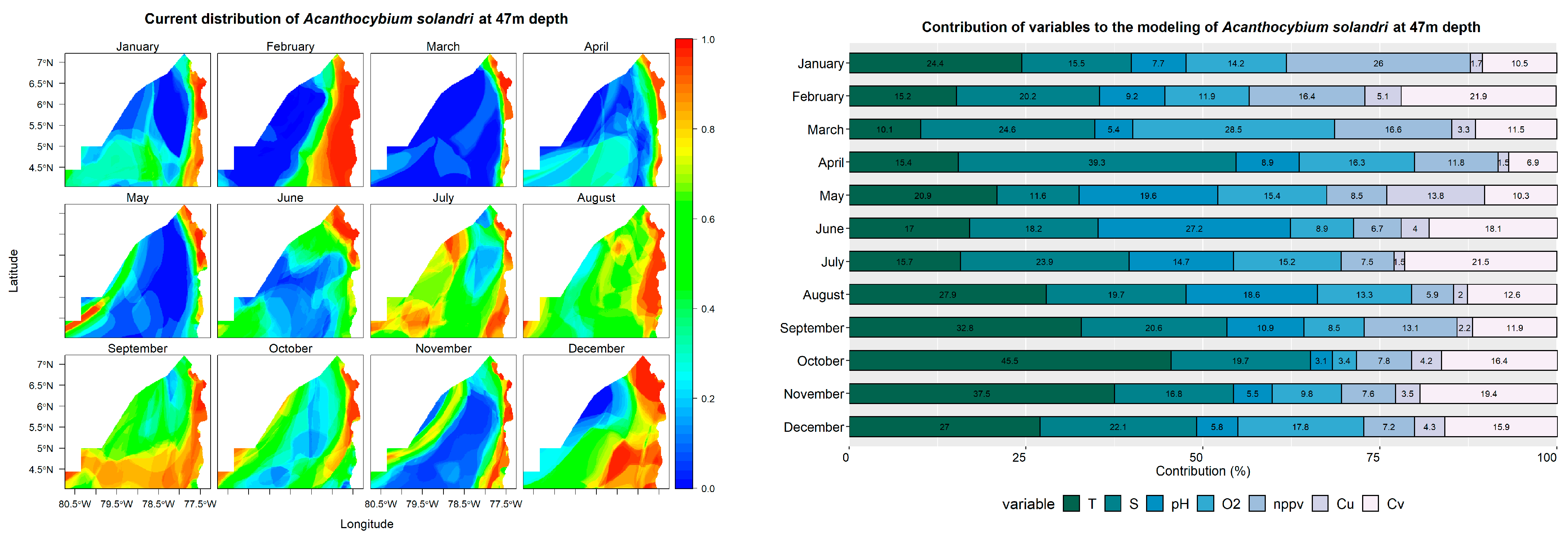
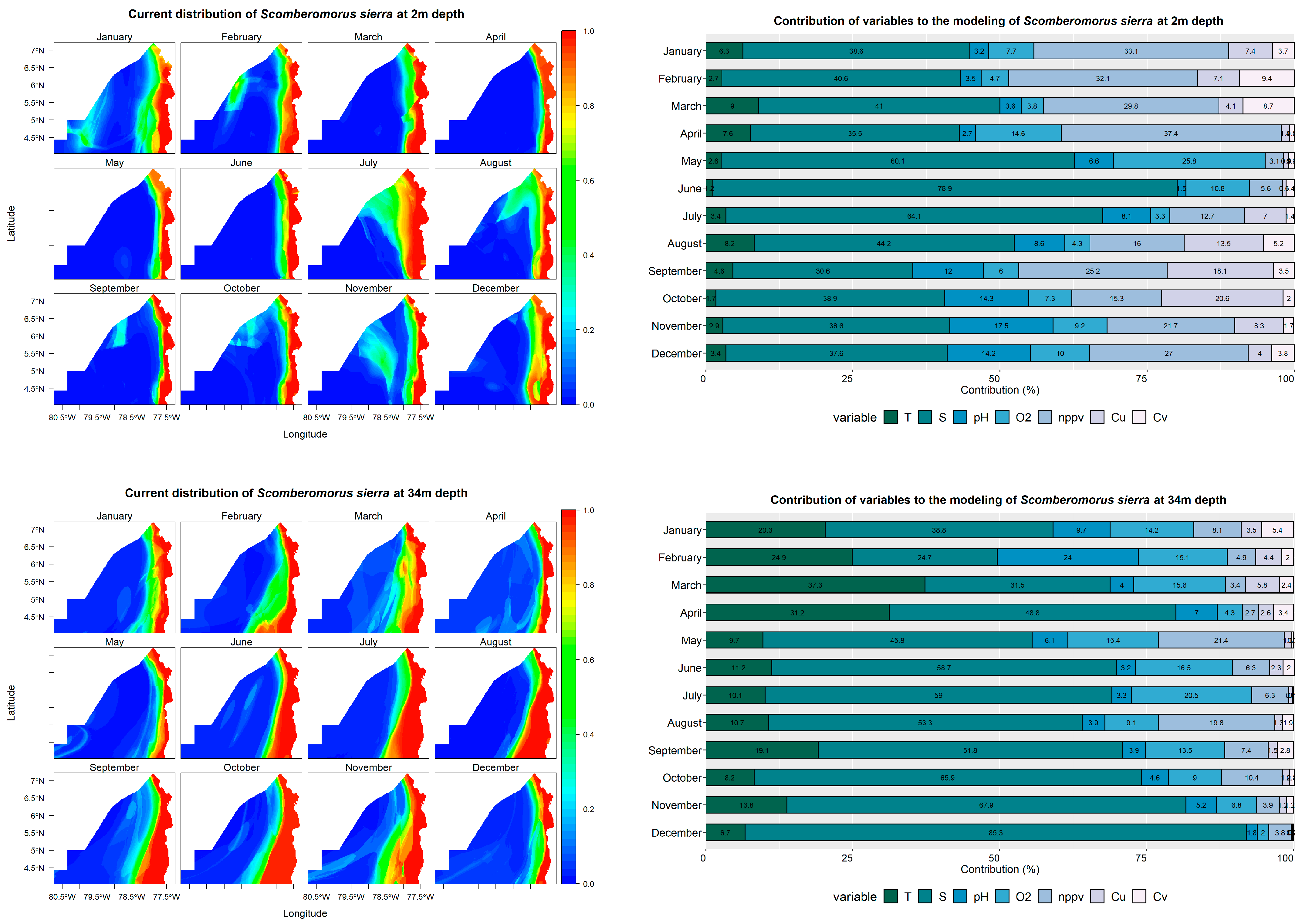
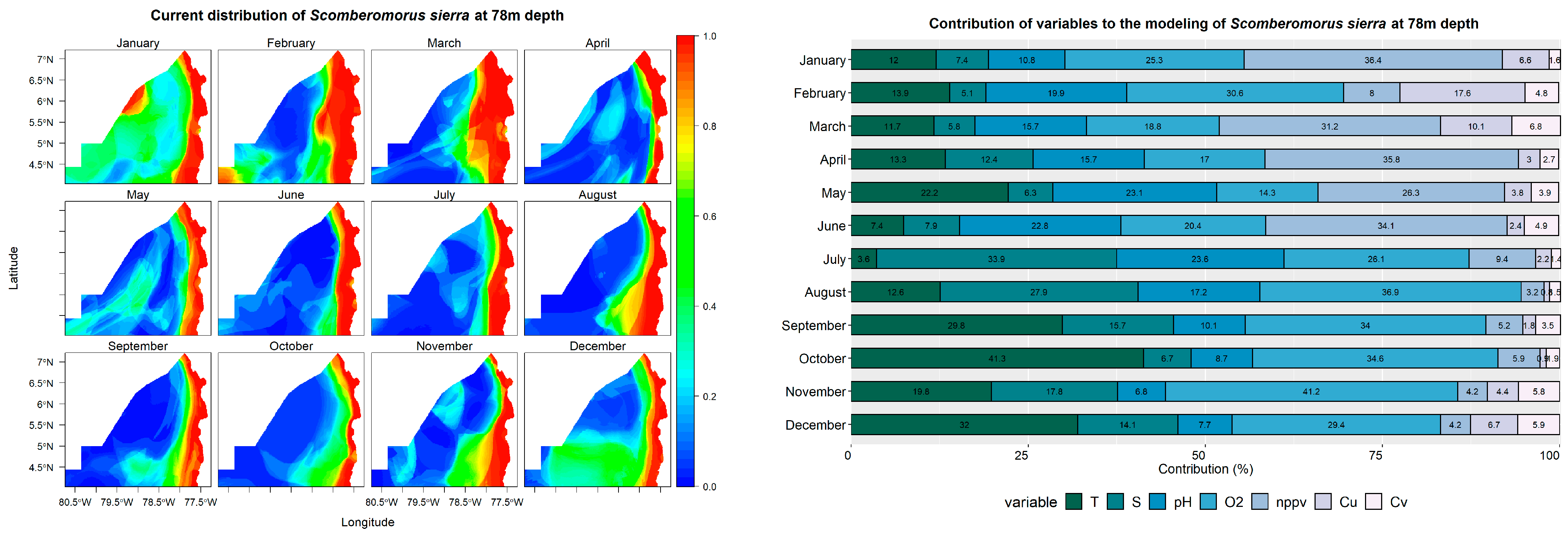
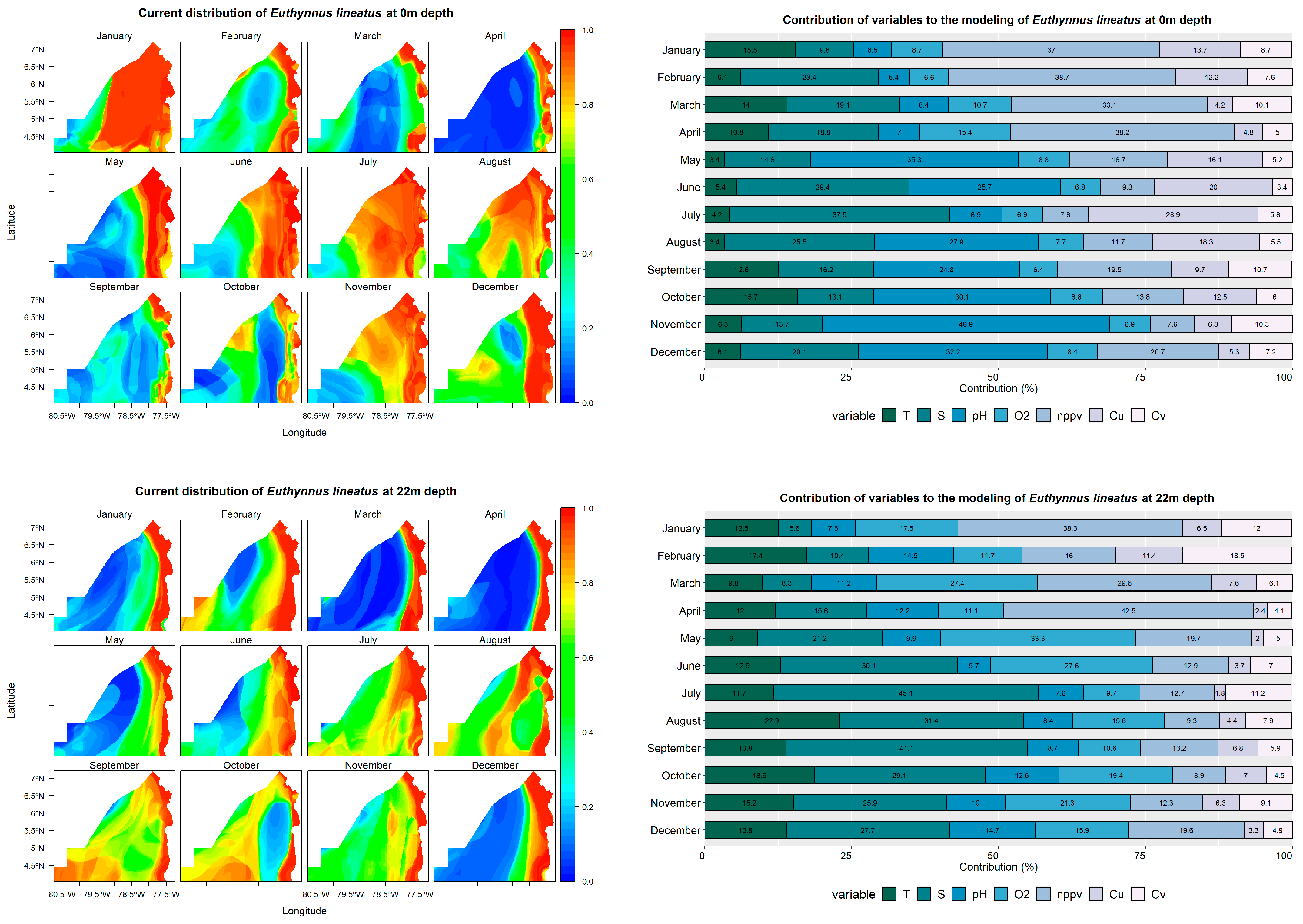
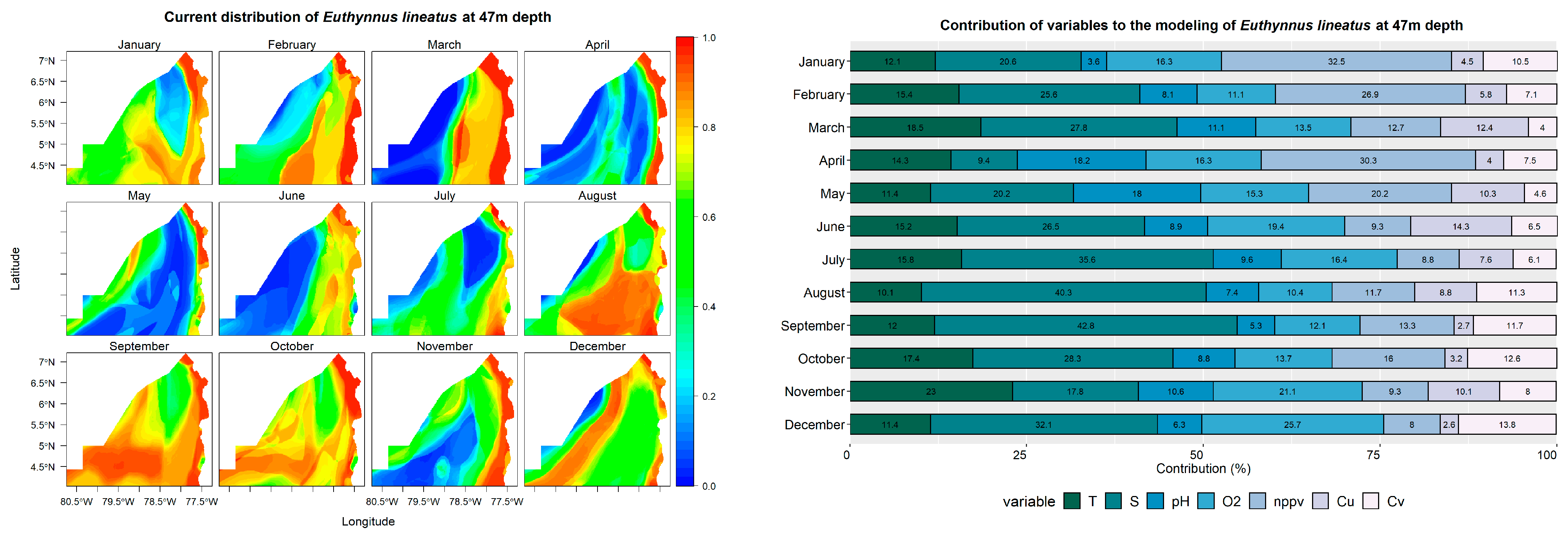
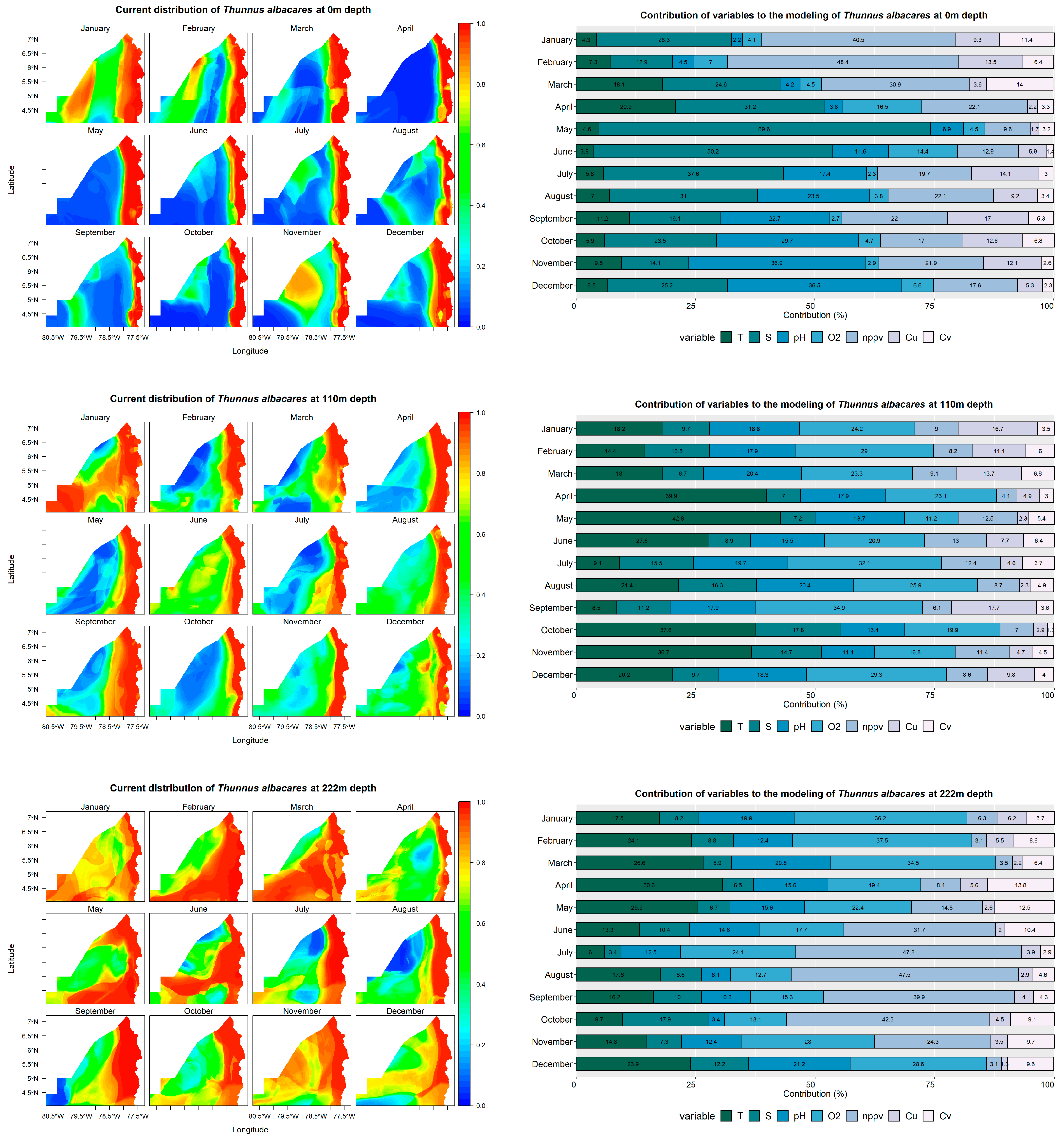
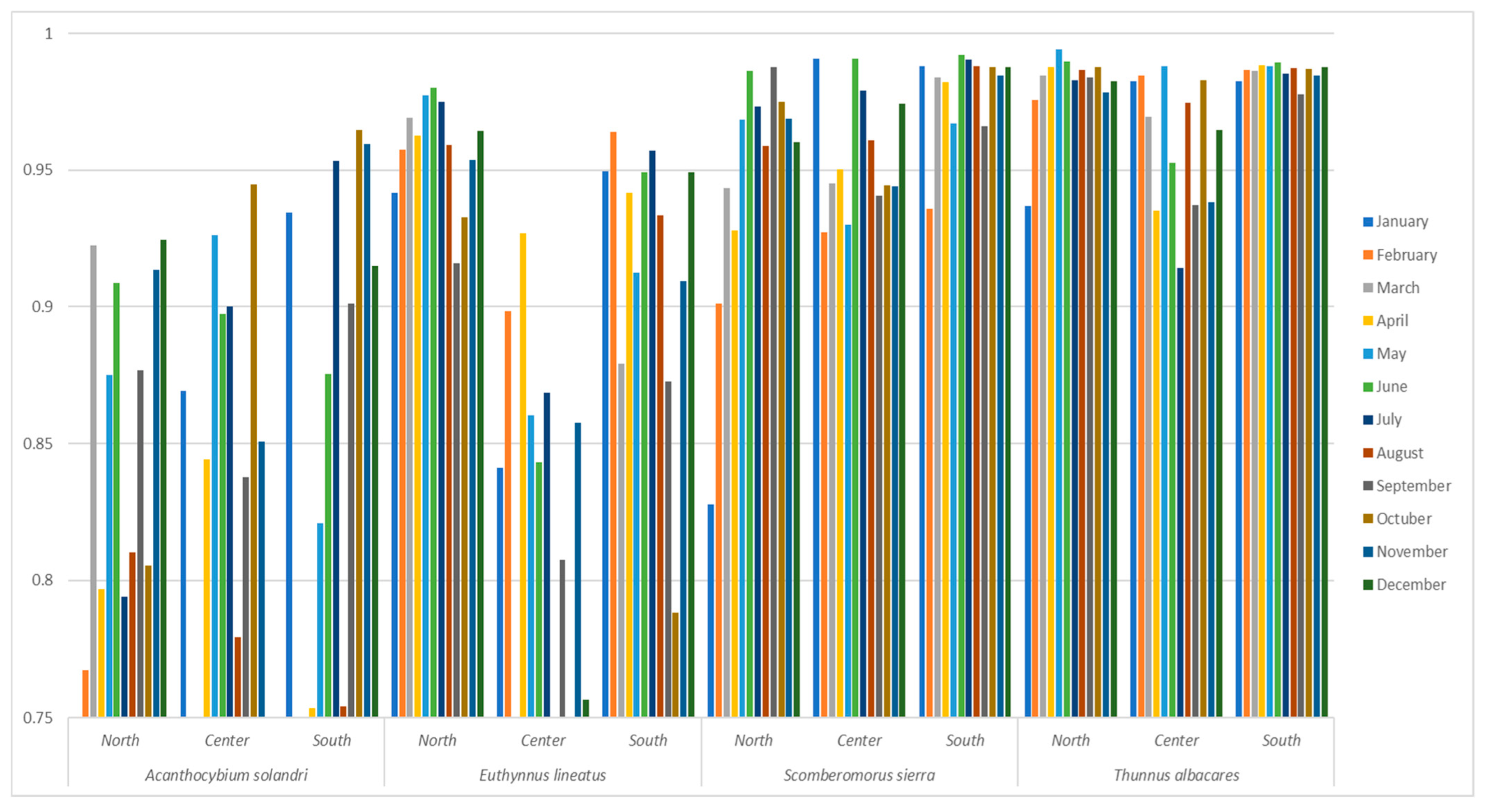

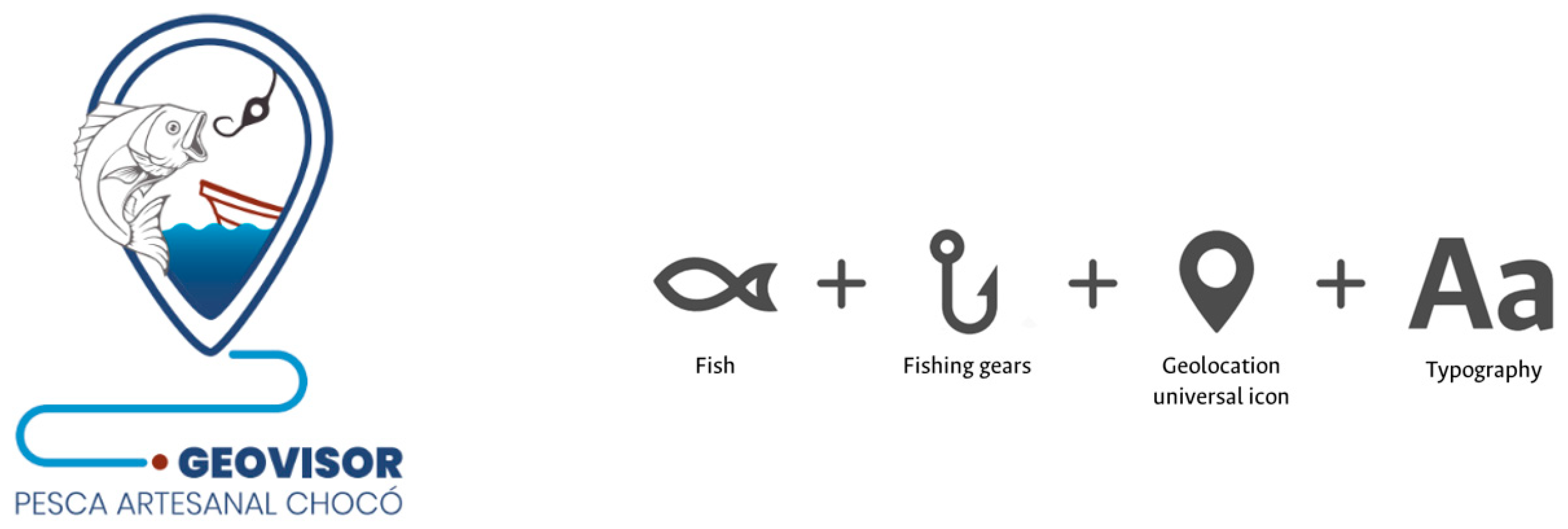
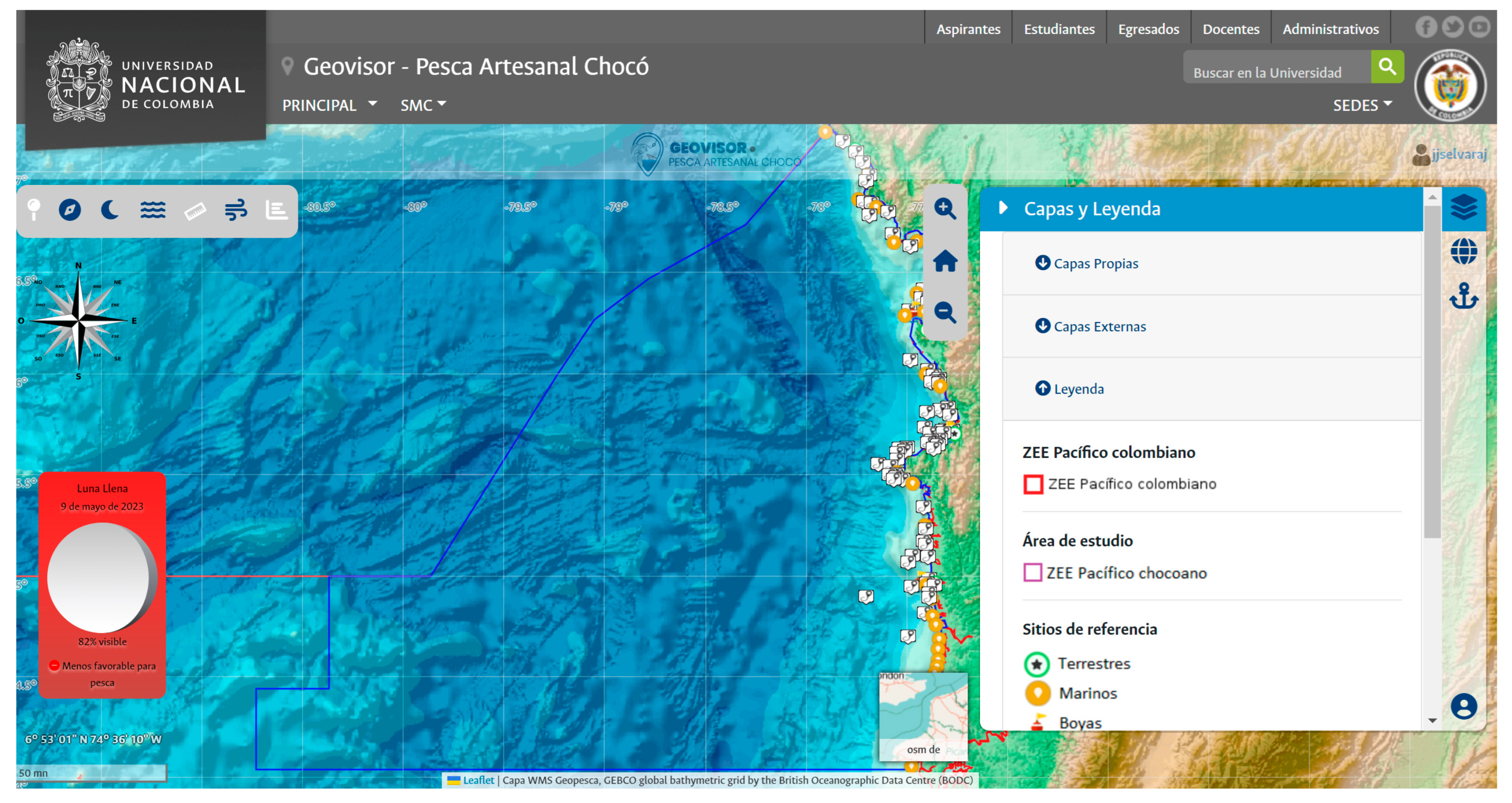
| Name | Regulation | Main Features |
|---|---|---|
| Exclusive Zone for Artisanal Fishing (ZEPA) | Resolution 899/2013 of the National Fisheries and Aquaculture Authority (AUNAP) and the Ministry of Agriculture and Rural Development | Establishes the ZEPA, included within 2.5 nautical miles counted from the lowest tide and limited to the north by the border with Panama and to the south by the northern limit of the Utría National Natural Park. Subsistence fishing is permitted in the ZEPA, while commercial, industrial, and exploratory commercial fishing are prohibited. The use of gillnets and fishing hammocks is also banned. |
| Special Fisheries Management Zone (ZEMP) | Establishes the ZEMP from the ZEPA limit to 12 nautical miles, in order to establish a fisheries management plan for the rational use of resources. In the ZEMP, industrial tuna fishing is forbidden with purse seine vessels having a capacity equal to or exceeding one hundred eight net registered tons. This prohibition also extends to longline vessels of a length greater than or equal to 24 m. | |
| Utría National Natural Park (PNNU) | Resolution 190/1987 of the Ministry of Agriculture of the Republic of Colombia | According to Agreement 052/1986, the PNNU is reserved, bordered, and declared with an area of 51,483 ha between the municipalities of Bahía Solano, Nuquí, Alto Baudó, and Bojayá. It is the preferred site for migratory species such as birds and whales, as well as being an ideal place for the spawning of different species of fish. The aim of PNNU is to conserve exceptional flora and fauna values and perpetuate biotic communities, physiographic regions, biogeographic units, genetic resources, and wild species threatened with extinction in their natural state. It also seeks to safeguard specimens of natural, cultural, and historical phenomena of international interest, contributing to the preservation of humanity’s common heritage. |
| Regional District of Integrated Management (DRMI) Gulf of Tribugá-Cabo Corrientes | Agreement 011/2014 of the Board of Directors | The Golfo de Tribugá-Cabo Corrientes DRMI is declared in the municipality of Nuquí, department of Chocó, with an area of 60,183 ha. It seeks to protect biodiversity along the gulf while putting into practice strategies to improve the living conditions of the population. The DRMI aims to conserve the habitats for the mating, reproduction, and breeding of the humpback whale and other emblematic, endemic, and/or threatened species. It seeks to maintain the structural and functional attributes of marine ecosystems and coastal communities in the area, support the cultural dynamics of Black communities reliant on the ecosystem goods and services of the Gulf of Tribugá, and promote the sustainability of hydrobiological resources and other goods and services that support fishing and extractive uses linked to marine and coastal ecosystems. |
| Regional District of Integrated Management (DRMI) “Encanto de los Manglares del Bajo Baudó” | Agreement 008/2017 Regional Autonomous Corporation for the Sustainable Development of Chocó | Agreement 008/2017 reserves, delimits, borders, declares, and administers the “Encanto de los Manglares del Bajo Baudó” Regional District for Integrated Management in the municipality of Bajo Baudó, with a total area of 314,562 ha. The primary objectives of the DRMI are to preserve biodiversity and the provision of environmental goods and services. The specific goals include conserving the productive capacity of ecosystems and the viability of wild populations for sustainable use and supply, as well as preserving populations and habitats for the survival of species of conservation interest. |
| Input Data | Type | Source | |
|---|---|---|---|
| Occurrence databases | International source | Smithsonian Tropical Research Institute’s Online Information System on Shorefish of the Tropical Eastern Pacific | |
| National source | INVEMAR’s SiAM-Marine Environmental Information System | ||
| International source | Global Biodiversity Information Facility (GBIF) | ||
| International source | Ocean Biogeographic Information System (OBIS) | ||
| Environmental predictor variables | Physical | Salinity | Copernicus Marine Service Global Ocean Physics Reanalysis (GLOBAL_MULTIYEAR_PHY_001_030) |
| Temperature | |||
| U currents | |||
| V currents | |||
| Biogeochemical | Net primary productivity | Copernicus Marine Service Global Ocean Biogeochemistry Hindcast (GLOBAL_REANALYSIS_BIO_001_029) | |
| Dissolved oxygen | |||
| pH | |||
| Family | Genus | Species | Common Name | Depths under Analysis | |
|---|---|---|---|---|---|
| International | Local (Spanish) | ||||
| Scombridae | Acanthocybium | Acanthocybium solandri | Wahoo | Sierra wahoo | 0 m, 22 m, 47m |
| Scomberomorus | Scomberomorus sierra | Pacific sierra/Seerfish | Sierra común | 2 m, 34 m, 78 m | |
| Euthynnus | Euthynnus lineatus | Black skipjack | Atún patiseca | 0 m, 22 m, 47 m | |
| Thunnus | Thunnus albacares | Natural Yellowfin | Atún albacora | 0 m, 110 m, 222 m | |
Disclaimer/Publisher’s Note: The statements, opinions and data contained in all publications are solely those of the individual author(s) and contributor(s) and not of MDPI and/or the editor(s). MDPI and/or the editor(s) disclaim responsibility for any injury to people or property resulting from any ideas, methods, instructions or products referred to in the content. |
© 2023 by the authors. Licensee MDPI, Basel, Switzerland. This article is an open access article distributed under the terms and conditions of the Creative Commons Attribution (CC BY) license (https://creativecommons.org/licenses/by/4.0/).
Share and Cite
Selvaraj, J.J.; Cifuentes-Ossa, M.A.; Penna-Narvaez, J.; Miranda-Parra, M.A.; Herrera-Rozo, F.A. Species Distribution Models as Tools for Community Empowerment and Informed Decision Making in Colombia’s Chocó Pacific Coast Fisheries. Fishes 2023, 8, 349. https://doi.org/10.3390/fishes8070349
Selvaraj JJ, Cifuentes-Ossa MA, Penna-Narvaez J, Miranda-Parra MA, Herrera-Rozo FA. Species Distribution Models as Tools for Community Empowerment and Informed Decision Making in Colombia’s Chocó Pacific Coast Fisheries. Fishes. 2023; 8(7):349. https://doi.org/10.3390/fishes8070349
Chicago/Turabian StyleSelvaraj, John Josephraj, Maria Alejandra Cifuentes-Ossa, Jeider Penna-Narvaez, Maira Alejandra Miranda-Parra, and Fabio Andrés Herrera-Rozo. 2023. "Species Distribution Models as Tools for Community Empowerment and Informed Decision Making in Colombia’s Chocó Pacific Coast Fisheries" Fishes 8, no. 7: 349. https://doi.org/10.3390/fishes8070349
APA StyleSelvaraj, J. J., Cifuentes-Ossa, M. A., Penna-Narvaez, J., Miranda-Parra, M. A., & Herrera-Rozo, F. A. (2023). Species Distribution Models as Tools for Community Empowerment and Informed Decision Making in Colombia’s Chocó Pacific Coast Fisheries. Fishes, 8(7), 349. https://doi.org/10.3390/fishes8070349








